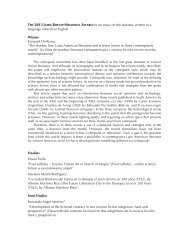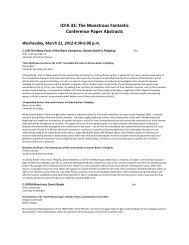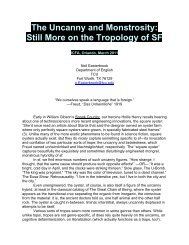93. (FTV/H) Monsters and Morality CypressChair: Brian RappIndependent ScholarDracula the Anti-Christ: New Resurrection of an Immortal MonsterMelissa OlsonUniversity of Wisconsin, MilwaukeeIn his introduction to Monster <strong>The</strong>ory, Jeffrey Cohen argues that we are what we presently fear. <strong>The</strong> monster “is born only at this metaphoriccrossroads, as an embodiment of a certain cultural moment – of a time, a feeling, and a place.” But if the monster personifies a certain momentin which it is born, what does it mean when a monster survives in popular culture for hundreds of years? Bram Stoker’s Dracula has neverbeen out of print, yet it manages to remain relevant to Cohen’s self-described “method of reading cultures from the monsters they engender”by continually redefining itself through new interpretations, both literary and cinematic. Because these interpretations are legion, it is all tooeasy to overlook an entry into the Dracula catalog that actually contributes something original, a fate that has befallen the ill-received 2000horror film, Wes Craven’s Dracula 2000. This film did embody a specific cultural moment, a breath that the world held between two millennia.In their attempt to modernize Dracula for the new millennium’s contemporary, cynical audience, the filmmakers incorporated a imaginativelybrazen statement about the infamous vampire: that he is actually Judas Iscariot, betrayer of Christ. With this bold leap, Dracula 2000 resurrectsthat which contributed to the original inspiration for Dracula: anti-Semitism. It has long been argued that Jewish stereotypes contributed toStoker’s imagery of his title character. Now Dracula is cast as the most hated of all Jews, and a dark mirror-image of Jesus himself. Just as hedrank the symbolic blood of Jesus at the Last Supper, Judas/Dracula now “drinks the blood of all God’s children,” giving them a new, damnedeternal life. <strong>The</strong> cinematic Dracula even goes so far as to promise God that he will remake the world in his own image, bringing full-circle themyth of the Jewish threat to Christendom."We're <strong>The</strong>m and <strong>The</strong>y're Us": Zombies, Evil and Moral AgencyJune M. PulliamLouisiana State UniversityUnlike other monsters such as the vampire, werewolf or mass murdering maniac—the zombie is not evil. Evil necessitates that one have moralagency to make a conscious choice to do right or wrong, to do good or to cause harm. Yet the defining characteristic of the zombie is a lack ofmoral agency. Zombies are slaves, either literally, as is the case in earlier works such as the 1931 film White Zombie, where they constitute anundead labor force, or figuratively, as in Romero’s films, where they are in thrall to an insatiable desire for human flesh. As slaves, zombies lackthe will to have moral agency, and so cannot be evil, even when they commit acts that harm humans. Humans, however, are evil, which isrevealed when they are in proximity to zombies. Zombie masters are evil because they deprive the living (or the dead) of their will. Yet humanswho terminate zombies with extreme prejudice are also evil. While humans might have to defend themselves against zombies bent oncannibalism, their desire to exterminate zombies prevents them from seeing the creature’s humanity and affiliation with the living. In thispresentation, I consider the zombie, from its beginning in Lafcadio Hearn’s “<strong>The</strong> Country of the Comers-Back” and William Seabrook’s <strong>The</strong>Magic Island, to more recent incarnations in George Romero’s Night of the Living Dead films, and in twenty-first century texts such as MaxBrooks’ World War Z Seth Grahme-Smith’s literary mashup Pride and Prejudice and Zombies. In all of these works, the zombie tells us abouthuman moral failings.From Monster to Hero: <strong>The</strong> Evolution of the Vampire in Fiction and FilmAntoinette WinsteadOur Lady of the Lake University“From Monster to Hero. . . .” examines how the image of the vampire has evolved from that of a monster to that of a romantic hero and theimplications behind this evolution. Beginning with the image of the vampire presented in Nosferatu (1922) and Dracula (1931), the paper willprovide a historical perspective on the initial concept of the vampire as a demonic figure. Moreover, it will show how this image graduallychanged to that of a misunderstood anti-hero with the introduction of Barnabas Collins in Dark Shadows (ABC 1966 – 1971) and Lestat in AnneRice’s Interview with a Vampire and how these changes reflected the cultural changes taking place in the late 1960s and the mid-1980s. Inaddition, the paper will address the latest incarnation of the vampire as seen in the Sookie Stackhouse and Twilight series, as well as in theBritish TV series Being Human, wherein all cases the vampire has evolved beyond merely sucking blood to actual intercourse, procreation, and,in the case of Being Human, eating food. As this paper will demonstrate, the vampire no longer represents an object of revulsion, but ratherrepresents an object of desire – a deadly desire.
94. (FTV/CYA) Monstrosity and Deviance in Supernatural Teen Dramas on Television PalmChair: Victoria ByardUniversity of Leicester“I don't know whether to kill it or lick it”: Sex, Love, and Power in MTv’s Teen WolfElson BondTarleton State UniversityMTv’s series Teen Wolf, which debuted in the summer of 2011, does update the adolescent lycanthropy genre, but, on the whole, the teendrama retains more tropes than it modifies, re-skinning rather than remodeling the parallels between ordinary growing up and shape-shifting.In particular, it retains such elements as absent parents, work/school tensions, male athletic success, sexual anxieties, and physicaltransformation. Its innovations—which, I argue, are significant to this generation of teen viewers—include more lethal, self-reliant femalecharacters, more sexually explicit content, a focus on lacrosse, and an increase in the male mentor figure, connected implicitly to a homoeroticelement that seems new to the genre.Dawson’s Creek of the Undead: How the Television Series <strong>The</strong> Vampire Diaries Puts the ‘Ick!’ back in GothicDeborah ChristieECPI UniversityThis paper examines the ways in which the television adaptation of <strong>The</strong> Vampire Diaries incorporates traditional gothic elements in a way thatrevises the “vampire with a soul” element common in late twentieth-century vampire romances such as Anne Rice’s Lestat series and JossWhedon’s television series Buffy the Vampire Slayer and more recent works such as the Twilight trilogy. In particular, <strong>The</strong> Vampire Diariesresists the easy connection between love and redemption and instead allows its monstrous characters to be monsters, albeit dangerouslyattractive ones.<strong>The</strong> Ties that Bind: Family Values in <strong>The</strong> Secret CircleMargo CollinsDeVry CollegeOstensibly the story of a group of genetic witches in a small harbor town, <strong>The</strong> Secret Circle(a television series adapted from L.J. Smith’s novels)focuses upon the ways in which a “bound circle”—a coven of six teen witches—must learn to work magic together in order to protectthemselves from witch-hunters and to learn the secret of their parents’ untimely demise. In its focus on family ties, both among geneticallyconnected family members and among the members of the created family of the bound circle, the show takes the traditional gothic fascinationwith the past (particularly the decayed past) and imbues it with new energy.95. (PCS/VPA) <strong>Monstrous</strong> Narratives MagnoliaChair: Eden Lee LacknerVictoria University of WellingtonMonsters and Mass Effect: Exploring the Fear of the PosthumanAmanda M. SchultzUniversity of Wisconsin - La CrosseBioware’s recent titles Mass Effect and Mass Effect 2 explore the contemporary fears of artificial intelligence. Each sect of AI represents varyingideas based on the posthumanism concept, showing the player three different possibilities of AI potentially causing the end of the human race.Sweetness and Night: <strong>The</strong> Lure of the <strong>Monstrous</strong> in Fan Fictions and AudiencesBarbara LucasIndependent ScholarGiven the fact that popular media often casts the monstrous as tragically romantic, it should come as no surprise that a majority of fan worksmirror that tendency and result in artifacts where the monstrous sparkles instead of stuns, where it is tamed and restrained within thecomfortable confines of traditional romance genre tropes. In discussing the intersection of the monstrous and the erotic, Clive Barker, whosework has been called “a vast torture garden of forbidden delights,” notes that “[w]e want the erotic experience to remove us from themundane, the banal. We want eroticism to transfigure us.” This impulse in which the dark erotic/romantic captures a loss of control and of selfalso exists within a much smaller subgenre of fan works, and by examining several fannish artifacts and fans’ responses to them, we will explorethe various pleasures offered by these artifacts.
- Page 4 and 5:
5. (F) Wondrous Bodies of the Gende
- Page 6 and 7: Fantastic Suicide: Reading the Unca
- Page 8: Viral Posthumanism: Boundaries and
- Page 11 and 12: The Concept of Soul Divisibility in
- Page 13 and 14: Thursday, March 22, 2012 10:30 a.m.
- Page 15 and 16: 21. (CYA) Terrifying Futures: Post-
- Page 17 and 18: 23. (FTV/H) Now I’m Feelin’ Zom
- Page 19 and 20: Fight Club: Amalgam of the Horrific
- Page 21 and 22: Taking the Monsters out of the Clos
- Page 23 and 24: Kaspar J. SaxenaIndependent Scholar
- Page 25 and 26: 44. (CYA) The Monstrosity of Teenag
- Page 27 and 28: 46. (FTV/SF) Monstrous Spin-offs: T
- Page 29 and 30: 49. (F) Aspects of Miéville Captiv
- Page 31 and 32: 53. (SF) War and Crisis in 1940s an
- Page 33 and 34: Abuse of Power: An Evolutionary Res
- Page 35 and 36: Disappearing Natives: The Colonized
- Page 37 and 38: 60. (H/IF) Ancient and Medieval Mon
- Page 39 and 40: 62. (F) The Works of Tolkien Captiv
- Page 41 and 42: 67. (SF) Imperial and Postcolonial
- Page 43 and 44: Beheading the Gorgon: Beautifying C
- Page 45 and 46: 71. (VPA) Monstrous Music MagnoliaC
- Page 47 and 48: 73. (F/IF) Portraying New Worlds Ca
- Page 49 and 50: Friday, March 23, 2012 2:45-3:45 pm
- Page 51 and 52: 81. (FTV) Those Damn Dirty Apes! Cy
- Page 53 and 54: Friday, March 23, 2012 4:00-5:30 pm
- Page 55: 92. (F) Leaving the Demonized Other
- Page 59 and 60: of cannibalism, ghostly seduction i
- Page 61 and 62: Saturday March 24, 2012 8:30-10:00
- Page 63 and 64: 104. (CYA) Classic Monsters, Reinte
- Page 65 and 66: 107. (VPA) Monstrous Gaming Bodies
- Page 67 and 68: who challenge the order that the Br
- Page 69 and 70: Reading Between the Times: A Critic
- Page 71 and 72: 117. (FTV) Monsters and Superheroes
- Page 73 and 74: 119. (IF/H/PCS) International Mash-
- Page 75 and 76: Focusing on Stoker's Dracula as one
- Page 77 and 78: Florida Atlantic UniversitySheri S.
- Page 79 and 80: Simmons CollegeIn the spate of rece
- Page 81 and 82: Independent ScholarKing’s story
- Page 83 and 84: modernity opens up for every indivi
- Page 85 and 86: Saturday March 24, 2012 4:00-5:30 p
- Page 87 and 88: 141. (FTV) Monstrous Masculinity Cy
- Page 89 and 90: ultimately make peace with her mons
- Page 91 and 92: where the almost-human sentient zom





